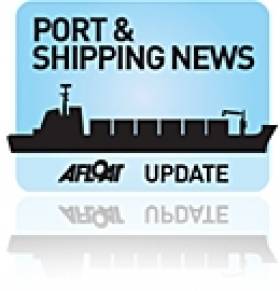Displaying items by tag: Heavylift cargoship
Biggest Vessel to Dock in Fenit Loads Cranes for USA
#SHIPPING CRANES – In what is believed to be the largest ship ever to dock in Fenit, Co. Kerry, the heavylift ship HHL Valparasio (2010/17,634grt) departed this afternoon with two ship-to-shore container cranes bound for the USA, writes Jehan Ashmore.
The Liberian flagged heavylift ship is transporting the cranes to Elizabeth Port, in New Jersey and were manufactured by Liebherr Container Cranes Ltd based in Fossa, outside Killarney.
The Swiss family owned business has been operating with its Irish base since 1958 and has a workforce of 560 employees. The manufacturing facility is part of a global group with more than 35,000 employees in more than 130 companies, in which the company was established in 1949 by founder Hans Liebherr.
As HHL Valparaso departed Fenit pier, two tugs assisted the 168m long vessel which had previously made her outward bound trans-Atlantic voyage from Norfolk, Virginia. On board was cargo of grain which was unloaded in Dublin Port earlier this month.
The two-year old vessel (P2 class) is owned by German operator Hansa Heavy Lift GmBH based in Hamburg and she was built by the Hudong Zhonghua Shipbuilding Group in Shanghai, China. The vessel belongs to a fleet of 21 multipurpose heavy-lift freighters engaged in the heavy-lift and project market.
The ships' on board cranes have harnesses of a combined lift capacity of 1,400 tons and facilitate the loading and discharging of cargoes around the world – independent of the local infrastructure.
With today's crane cargo which forms the only major business running out of Fenit, which has operated as a commercial port since 1887, the Co. Kerry harbour has had 12 such shipments in 2012. According to Liebherr a further seven such exporting cargo-calls are scheduled for the rest of this year.
Mauritius-Bound Ferries Finally Bid Galway Farewell
First to be loaded was the Clann na nOileáin on Wednesday in an operation than took four-hours while on Friday her sister Clann Eagle I took six-hours to be winched safely onto the cargo-deck during freshening winds.
It is ironic that since Thor Gitta 's arrival to the port's Dún Aengus Dock on 5 April that it would also nearly be the same time taken for the estimated 25-day delivery voyage of the ferries to the Indian Ocean island.
During the 8,300 mile journey Thor Gitta will make several port of calls with the first call to La Rochelle. The Bay of Biscay port is the next largest port south of Les Sables d'Olonnes, where the fast-ferries where built at the OCEA boatyard for her original owners Bád Arann Teoranta which traded as Aran Direct on routes from Rossaveal to the islands.
Thor Gitta was built in 1996 and is also designed to carry 364 TEU (twenty-foot equivilant unit) containers and belongs to an-eight strong fleet operated by the Danish company, Thor Rederi A/S of Svendborg.
One of the reasons why the heavylift vessel was delayed in loading was to ensure the correct positioning of the ferries so not to further disrupt other port call cargo allocation while on the long repositioning voyage to Mauritius.
The 4,078 tonnes cargsoship is also scheduled to make en-route calls to Pointe Noir in the Congo, Cape Town and Pemba in Mozambique before finally reaching the southern Indian Ocean destination.
When the ferries were completed in 2005 and 2006 they were valued between €5-6m but they only served up to September 2008 when the 243 passenger aluminium built craft were laid-up at the Connemara harbour due to financial difficulities.
This led to the company going into receivership and the vessels were put up for auction in Galway last February. Despite bids reaching €950,000, they were withdrawn at the auction hosted by the Cork based auctioneer, Dominic J. Daly.
In the following month the fast-ferries were sold to the French owner for a new career based from the island state which is in the Mascarene Islands. Mauritius is neighboured by the smaller islands of Agalega, Cargados Carajos, Rodrigues and the French island of Réunion some 200km to the southwest.






























































